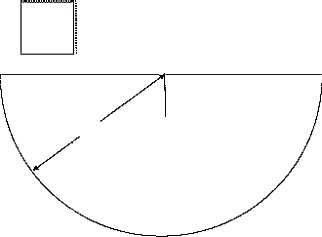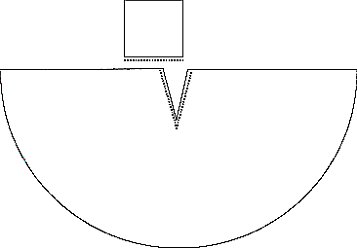|
|
| |
|
| |
General point : The best place to buy material is at a reenactors
fair as you will then be able to check if the material is authentic
for the period (there probably never were any callico legionaries).
The price will also probably be less than you would pay in the high
street, and the stall holders are usually a fairly good judge of
the amount of material you will need.
|
| |
The Tunica

|
Basic shape of tunica with sleeves.
Materials : wool, linen
Colours : Blue if legionarii, green if auxilia
Hamians may use cotton
The design of the under tunic is the same except that you
can do without the sleeves. Use a linen material for the under tunic.
|
| |
The Tunicae is the basic uniform of the soldier,
for the legionary (and to a certain extent the Auxilia), it is a
very easy piece of kit to make your self even with minimal sewing
skills.
In its simplest form it is a long rectangle stitched up the sides
and top with two slits left at the upper sides for the arms to come
through and one in the top edge for the head. A variation on this
would be to make it as a very loose T shirt style with short sleeves.
Either way though it should be long enough to fall to mid calf,
the length is then hitched up over a thin belt or leather thong
tied around the waist. Under tunics made from white linen or cotton
would be of the rectangular pattern. They could also be made from
wool but will probably be a bit too itchy for our modern 21stC delicate
skin.
|
| |
The Sagum.
The Sagum is a simple square of cloth which would
be pinned at the right shoulder with a brooch. The normal dimension
of this would be 1.5 to 1.7 metres. As most suppliers now sell wool
cloth in widths of 1.5 metres that rather sorts the dimension out
for you.
Top
|
| |
The Paenula
This needs some manufacturing
to take place but again is not too difficult.
It is a large semi circle which then has a square hood stitched
onto it.
The radius of the semi circle is 1.5 metres so to make this you
will need to buy a length of 3 metres. To get the semi circle mark
the centre of one of the long edges and hold one end of a piece
of string to this point. Measure out the string to 1.5m and tie
a piece of chalk to the other end. Hey Presto a home made large
compass. Mark out the semi circle and cut it out.
You should have enough left over material to cut out two 30cm squares
to make the hood with. Stitch two edges together as in the diagram.
This will form the back and the top of the hood
Then you need to cut a slit 20 cm long in from the centre of the
long straight edge. Stitch one of the loose edges of the
hood to each side of this slit. NB the two edges you have already
sewn together of the hood should form the back and the top so make
sure that the back is at the point of the V in the slit (see diagram).
This will leave about 10cm of the hood over the edge of the semi
circle. You can then stitch the protruding edge to each side of
the semi circle as this will pull the hood forward over your shoulders
when wearing it.
You can then either fasten the cloak at the
throat with a large brooch or attach it together with three toggles
which would have fastened across your chest. These can be carved
from wood (not too hard esp if you were a boy scout), or made from
horn which can be bought from traders fares.
|
 |
| |
 |
| |
 |
A variation on this form of cloak was the circular
pattern whereby you would need to make two semi circular lengths
which would be stitched together about 120 cm along one of the straight
edges. The hood is made as above and then attached with the rear
seam beginning where the two halves of the cloak have been joined.
Fastening is as for the semi circular cloak above. This will create
a large but very warm cloak, perfect for very cold weather.
Top
|
| |
Use
pigs fat or camping waterproofing to weather proof the cape. |
| |
Bracchai / Feminalia
Method 1 : Bracchai.
The auxilia wear the brachai. The easiest
method is to find a pair of jeans and trace around them for the pattern.
Leave enough material above the waist to fold over for a leather thong
to pass through. Brachai can be fairly loose fitting but try to avoid
them being too baggy. Brachai may extend all the way to the ankles.
Method 1 : Feminalia
feminali have nothing to do
with women, despite being worn by the legionarii, they're to cover
your femurs! A similar method to the making of the brachai can be
used, but the fitting around the legs must be fairly tight. These
should only extend to a point mid way down the calf muscle.
Some of the legionarii prefer to wear puttees (I'm not sure
what the latin equivalent is). For these all you will require is
two rectangles of material and some twine. Wrap the rectangles of
material around the legs and fasten with twine!
Top |
| |
Helmet Liners
Rather than use the black balaclava look that proved
so popular recently this offers a more stable (less slipping on
the head) and more authentic appearance.
To make it you will need some cloth (a metre square
should be fine - colour is irrelevant though avoid using your old
Teletubbies pyjamas as upturned helmets may be on show to the public),
needle and thread, a smallish dining plate, a saucer and no sticky
back plastic.
Draw around the plate and then place the saucer in the centre of
the resultant circle and draw around this. Repeat for the second
piece. Having done this cut out the two large circles.
|
 |
| |
Stitch the two circles together all around
the edge and then all around the inner circle (see diag.). Leave
a small gap in each line of stitches of about 4cm.
Having done this you should fill the inner circle
with small strips of cloth to pad it. Regularly check the amount
of padding needed by placing it, in the helmet and sticking it on
your head. When it is comfortable and the helmet brow edge is at
an acceptable position over your eyebrows then stitch up the gap
in the inner circle. Then do a similar padding of the outer rim
though be careful to evenly spread the padding around the circle
and don't over fill this area. Frequent checks will help get it
right. Once comfortable stitch the gap. The liner can now be secured
in the helmet either with glue or double sided tape. You can then
make a thin roll of material which call be fixed into the inner
edge of the helmet to lie against you forehead and around the sides
and back. The result will make your head fit snugly into the helmet
without peeking out and looking rather unauthentic - very undesirable.
It should also stop the sweat dripping into our eyes so you won't
need to wear the kamikaze ninja turtle style head band.
Yes I know the Roman's didn't have double sided tape
but by using this you can always remove the liner periodically to
wash it - not a bad idea unless you want to smell as if you've bathed
in pig fat.
Adapted from the
Armae web site article
Top
|
| |
Calligae |
|
| |
|
|
| |
The most important item of kit for any infantryman has and always
will be his boots. When you join you should contact Mestrius our
resident cobbler to get a pair of Caligae made up. You will need
to draw around your feet on a piece of paper and then mark them
up L and R this should then be sent to him (Contact details will
be given to you when you join). Instructions on looking after tne
boots will be given to you when you receive them. One thing that
often confuses a tiro is how to lace them up so enclosed are some
instructions
.
The lace should be placed so that its mid point
is in front of the first pair of boot straps A in the above diagram.
You then go from the outside through the first strap and across
to it's opposite partner. Down to the second strap, through and
across, this is repeated for each strap. When you get to the fifth
strap which has double slits instead of going across to the front
slit you go across to the second slit B in the diagram. Some people
then prefer to tie a half knot after this double strap. You then
continue this process up the remaining straps until you get to the
top of the boot finishing it off with a bow or double knot depending
on your preference, (remember though a double knot is hard to undo
when you've got cold wet fingers and the pub is beckoning at the
end of the day).
|
|
|

